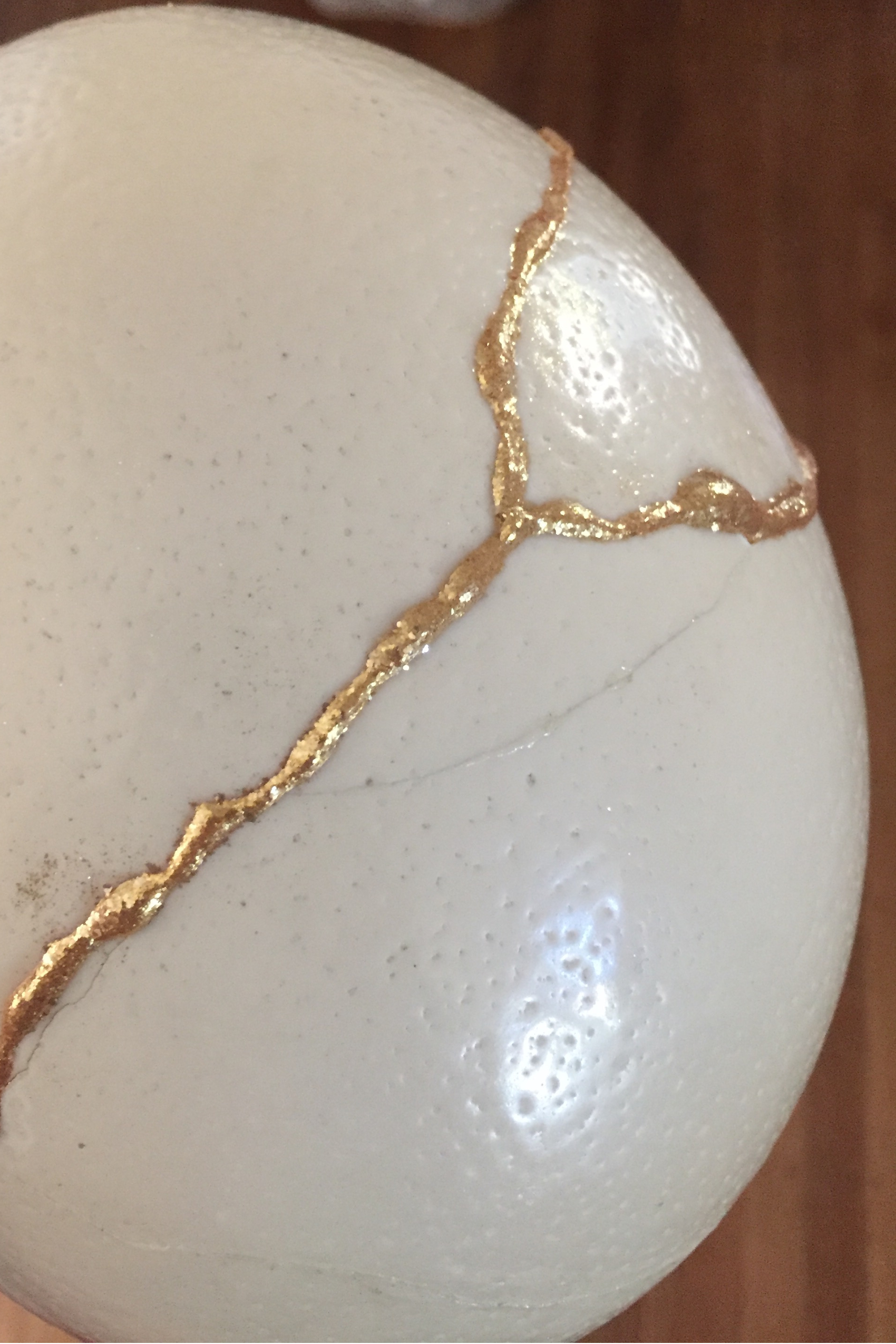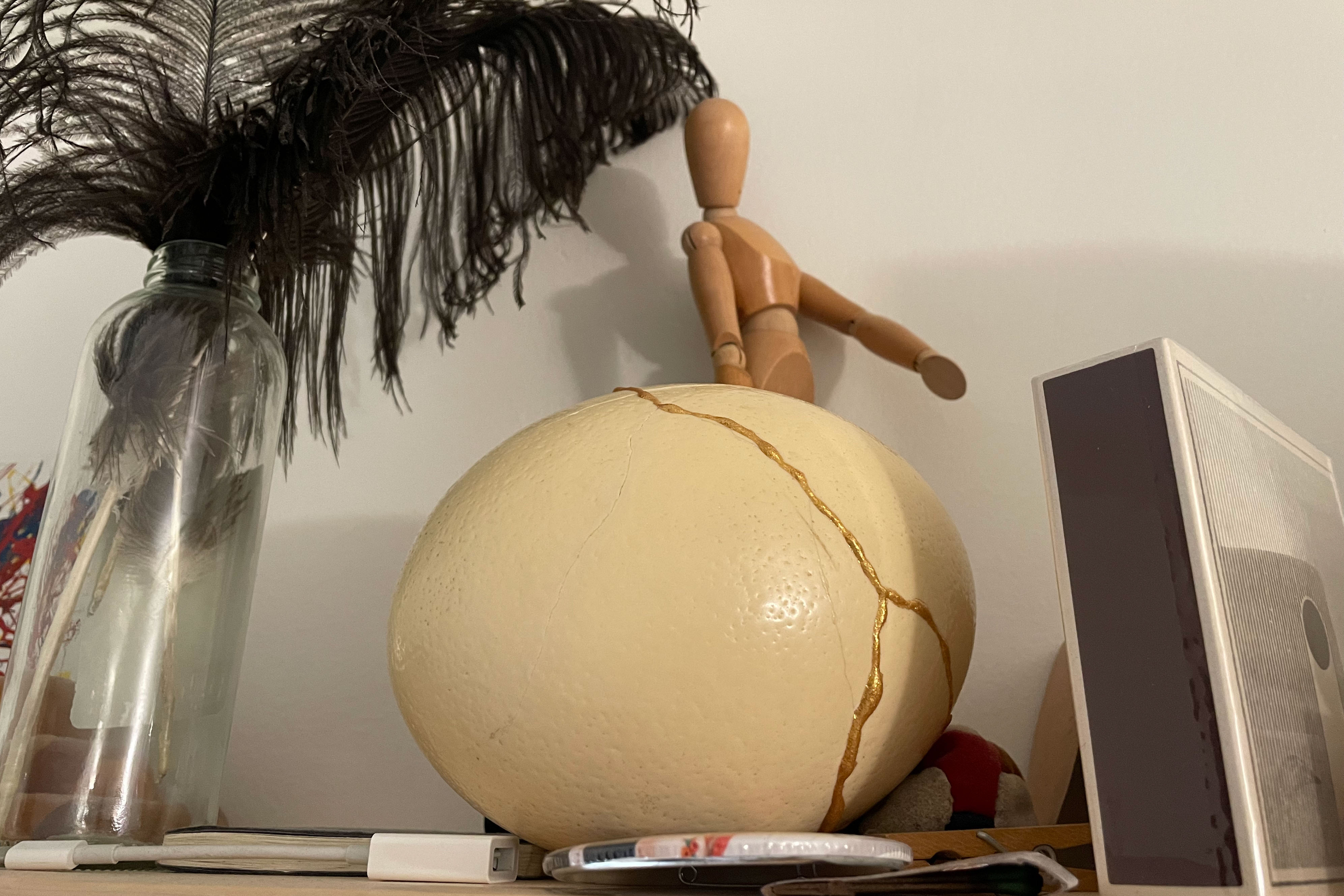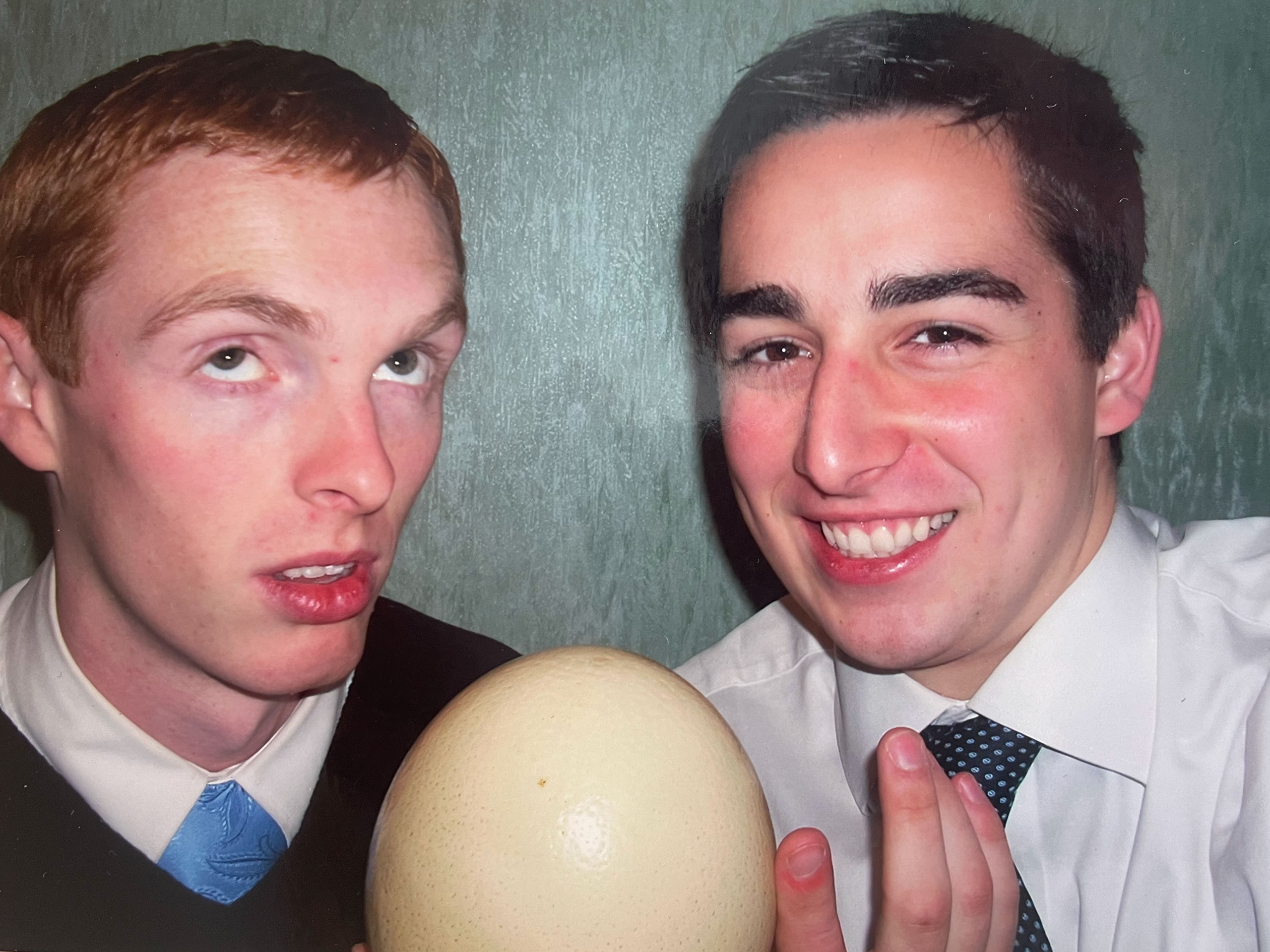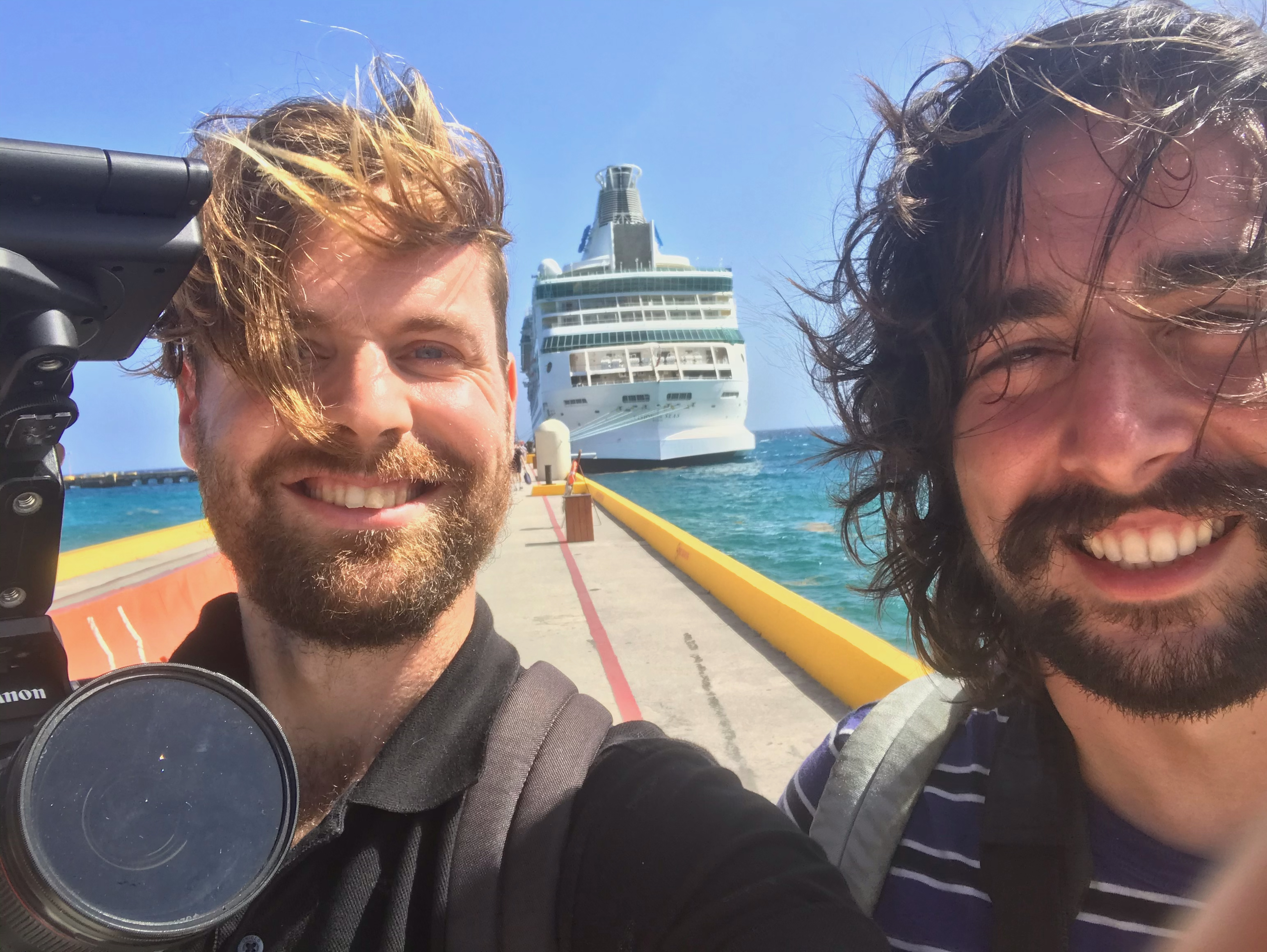Euology for a Film, Then its Reincarnation
Eulogy for Ostriches at Night Film
By Jake Chamberlain
Written August 2019
Revised May 2023
This eulogy begins with the time I purchased an ostrich egg in Ukraine, to eat. I was 21. I brought it into the kitchen, took it out of its box, and knew then I would never part with the beautiful dinosaurlike eggshell. I didn’t buy just eggs for four breakfast burritos! I bought art! A beautiful, simple, off-white organic orb, a symbol of life. Instead of cracking it open, I drilled holes in the top and bottom and pumped the egg liquids into a skillet with a bike pump, added cheese, called my friends. The ostrich farm I bought it from must’ve done something similar with their shells, as I’d seen them used to make large pysanky. My shell, which ended up cracking anyway when I moved home, sits on my bookshelf next to an ostrich feather I recently collected. I epoxied it together with gold dust mixed into the epoxy, inspired by the Japanese art of Kintsugi; its broken and even prettier. By the way, if you’ve never had one, it tasted like an “eggier” chicken egg.


Shortly after eating that egg at 21, I began to doubt the existence of the human soul. A cause-and-effect relationship of this big change in me to the egg is unlikely. Like many Mormons, I had a faith crisis after my two-year mission (in Ukraine). To get a grip, I pursued a bachelors of science in anthropology. I am unique in that I wanted the crisis to happen slowly and to avoid the switch to the scientific notion that we are only biological beings, “meat bags” as one ex-Mormon friend put it. My primary realization was that God may or may not exist, but if he does its hard to believe that he’d want everyone to be Mormon. My secondary questions, which I never got around to answering, were, if we don’t have souls, whats the deal with right and wrong? My interest was particularly piqued by literature on religion in anthropology. I re-read The Origin of Virtue by Matt Ridley a few times. Are right and wrong really just social constructs and game theory? I couldn’t be sure.
It went on through 28 when I started Stanford’s MFA Program in Documentary Film & Video. There, I made a film about my faith crisis called Non-Correlated. Editing it like crazy, I broke away to watch David Redmon’s donkey films. Choreography resonated with me, in particular. In each shot, donkeys on a farm look right into the film camera lens like they know they are performing. I thought maybe animals have souls or maybe I’m an animal performing faith and a faith crisis. I, too, was on a farm of some kind. I, too, look into the lens a lot in Non-Correlated. I’d never felt like a donkey before.
The film I am eulogizing was the treatment for my thesis. My project was to be a short verite-style documentary about a nighttime delivery of ostriches in Watsonville, CA. One farm was selling thirty birds to another and they were planning to move them at night in livestock trucks, customarily with socks on each bird’s head. Ostriches are aggressive and difficult to manage unless blindfolded, and, with that headshape... They’d arrive with headsocks like prisoners in Guantanamo. They’d walk rigidly, led down a plank. I had to film it! This project, on the heels of my faith crisis film, was to help non-religious people relate to my confusion with humanity and to express my new tinge of jealousy toward animals who don’t know virtue and vice. I was going to focus on dark shadows and bright work lights in the background of the birds.
It might look like a film on the ostrich industry, I was told. Without dialogue, how could it say anything about souls? Ahh the MFA student! My pitch fell flat and I felt dumb. My grandma told me to just make another film about immigrants. I don’t really do social issue films. The faith crisis was still a black hole with lots of gravity pulling on me, so I regrouped. Instead of Ostriches at Night, I made another personal film about the Book of Mormon. My actual thesis follows a Mormon tour group on a cruise to the Yucatan, where they look at the Mayan ruins with their own interpretation (which is that the Mayans were Jewish). Its called For the Love of God.


Left: A 2009 selfie. My companion, Elder Campbell, thought the $40 egg a bad use of sacred funds.
Right: My classmate and friend, Barna Szasz, thought my thesis a great use of personal funds.
Animal minds was an itch I couldn’t scratch in religion or personal filmmaking and my studies coalesced more around this topic. I got more into verite and sensory ethnography. I was surprised to find these modes in my own archives from my teenage years, stuff I shot that got me into filmmaking, but which I never thought valuable in an academic sense. I fell in love with the documentary Leviathan (2012) by Lucien Castaing-Taylor and Verena Paravel. I got to know Kirsten Johnson and her work, having studied Cameraperson (2016) earlier that year. Top of mind now, just because I‘m writing this, are also Gunda (2020) by Viktor Kossakovsky and Bestiare (2012) by Denis Cote. Worlds opened up about animals, humans, rhetoric, and media. Particularly curious, still, is the blurry line between fiction and non, and how this applies to animal footage. Ideas for new films came out of the woodwork that year and have taught me, may most of them rest in peace. Thought experiments from that era:
If you film a play, Shakespeare lets say, from a seat in the audience, people call this content fiction. If you film it from the wings, it feels more like a documentary about acting. The action is the same, the footage is just accompanied by a different mindset.
If I interview a subject on camera its clearly non-fiction. If I ask the subject to describe a dream they had, is the footage still non-fiction? Yes it is. They really had that dream. It doesn’t matter if the dream was about a flying dishwasher. What if I put this audio over a drawing of their dream? What if I cut out the part of the audio with my prompt? Add music? It would be labeled fiction, even though - once again - the subject really did have that dream and so its literally, factually non-fiction no matter how its edited. How many fictions out there are factually non-fiction? Is the Lion King a documentary to someone at least in essence? One last critical side-bar question about dreams: to the extent that they fit in the non-fiction category in the first place, is this more because they are unintentional or more because they were spoken of in a recorded interview? Either answer is bizarre.
When an animal is on-screen is it fiction or non-fiction? Can you only answer this if you know the context that footage gets placed in, which is the film’s rhetoric? What if you just personally disagree with the director? There have been documentaries made using non-fictitious facts and footage, but which deny climate change. Does your answer about animal footage change depending on whether the animal is trained or wild? What if the director has no idea what the animal will do and is determined to include the shot a priori in the final edit, like in a nature doc? What if its a nature doc inside a written character-driven story?!
When I was getting into filmmaking, dad put a Go-Pro on Coho, our best cross-country skier.
I took a course with visiting Professor Kerry Tribe who asked me to put these questions and my archival material into a project. In one, I filmed an octopus in a tank and added texts. The texts were actual texts between me and my sister Nat, who didn’t know I was going to do this (thats how its a documentary but I’ll let the viewer decide about what). I made a second short following rabbits at night called Hiding Place. These films exist and need no eulogy, but they weren’t my best.
That ostrich egg hatched lessons and lessons. Animals both off- and on-screen have their own intentions that we can’t always know or manipulate, which means animal clips are non-fiction a priori, I believe. With this firmly in mind, I’d love to argue how 1997’s AirBud is non-fiction, though I won’t here. But one bizarre step further: if the non-religious side of me wins-out and humans really are just animals not held to a higher moral standard or God’s scrutiny, then written comedy films with actors are in fact nature documentaries about homo sapiens. It has to do with what “level” your point of view is on, whether your under a God or are on the highest level, yourself, as a human. To an athiest Seinfield has to be a comedy by humans for humans. To God or a cosmic entity or a true believer above humans, Seinfield is non-fiction because it was made by a lower class, human-animals. Like how monkey behavior including singing is non-fiction to a primatologist. Yes - its non-fiction music.
Hope I didn’t lose you. I’ve also learned that people like fiction but LOOOOVE non-fiction. Or the part of fiction they say they love is actually the factually non-fiction part, and they forget that when they talk about it. I liked Succession. I LOOOVED the non-fiction part of Succession. With Ostriches at Night having gone the way of the dodo, I am now creating a new entertaining project and developing the rhetorical footing to exploit the combination of realizations in this and the previous paragraph. It is a TV show called Animal Minds. In it, I set Mormon filmmaking aside and instead look directly at God through animals. Read the blurb after the final treatment for Ostriches, below.
To Ostriches at Night - they said this would happen. This is what an MFA is: you get stoked on a great idea you can’t produce and your degree is in fact a held-in sneeze, on steroids. I loved you, my idea, graduated without you, now I mourn you. An iniated filmmaker is mourning all the time. The other experiments didn’t do what you’d’ve done. Now I see that when someone watches a film, what they’re watching is actually just the euology for the film the director wanted to make but couldn’t. This time, though, this essay is the only good-enough eulogy. I’ll end it with the final treatment I wrote of you in early Covid. This doesn’t mention socks or trucks but its still helping me kick the question further down the road, about right and wrong. And its still at night. Night is when the mind is more free. Be free, Ostriches at Night. You’ve changed me.
Ostriches at Night (2020) is a short experimental documentary film about how either:
1) human beliefs, stories, and media are totally ridiculous biological byproducts, or
2) animals and humans are equal, cosmically or under God, there’s no such thing as sin, or
3) animals are capable of belief, they’ve just been shy about it. So what are animals’ beliefs?
I am most interested in number 3. In my film, ostriches in their pen at night will hear and react to a series of sounds played on a speaker system. Later, a projector is set up and the ostriches are shown a series of films about ostriches, culminating in a film of a lion hunting on the savannah. Do the farmed birds believe in predators? Will they freak out?
The uselessness of this exercise speaks to the ridiculous human beliefs about ourselves, our media, and animals. Statements 2 and 3 emerge in the other content shown to the birds in the middle, such as films of an ostrich mating dance and an egg hatching. If they pay attention, they should stir or maybe “learn” something, before they see the horrific lion film at the end. And any cut to the farmer or me, the director, will speak to the notion of a perpetrator.
Lastly, if the birds just aren’t interested in the projector screen or are unable to follow motion pictures - isn’t this also interesting? In this case, it would be a film of birds milling around or asleep while a director shows them content he thinks is relevant to them. Its hilarious.
I’ve got to leave to pursue my new God project. See you in there.
Animal Minds TV Show Blurb
By Jake Chamberlain
May 2023
Ostriches at Night was stillborn and eulogized fondly. From its ashes or from the egg hatch, I have ten episodes. I was producing independently in SF when Covid hit and I lost all my gigs. I’ve spent time studying consciousness, philosophy, anthropology, myths, linguistics, fiction writing, and psychology experiments - see my annotated biobliography. I now work as an art teacher and I write. At various times I thought this was a literary review, a feature film, and a dissertation. Five years after Ostriches, I’m prepared to share this blurb. I hope I won’t have to mourn it, too!
Animal Minds is a TV show for 35-year-olds literate in science, religion, and film. In it, animal experiments which have been designed with massive creative license are presented in doc form, the animal reactions remaining unpredictable - critically so - to the writer/producer. The experiments are led by fictional scientists, August and Peter. It may be a “hybrid” format.
The two fictional scientists are enemies wrestling for control of their animal minds lab called Ur. August, the founder, loves animals. Peter loves himself. The story begins right after some of their joint projects had gained notoriety. In the first episode, a new wing is announced: a school for animals. Institutions financing it hope to identify a few species that can grow in tiny and specific ways to be able to participate in a redesigned internet, new currency, and new narrative for Earth.
Each episode contains a non-fiction part about a different experiment or procedure to (fictionally) condition the animals. The season culminates in a stageplay production of the story of Adam and Eve, played by animals who’ve been made ready to face a dilemma. Stretching certain theories, its the concept of dilemma that is the seed of consciousness. August plays the voice of God. Will the animals grow into their new role and use the new internet?
The first season is a tragedy for August. After a tussle with his nemesis, August requires surgery. In the end, sadly, he’s reduced to a living brain in a vat. He can communicate yes and no only, by thinking of playing tennis or walking around his house, respectively. In charge, Peter can connect a microchip to August’s genius god brain. Season two is a high-tech and surgical retelling of The Transfiguration. Its important in the current climate to say that I hope to avoid the subject of AI.
If you read the Eulogy for Ostriches at Night:
The biblical story of Adam and Eve is a 1:1 documentation of my adolescence, I think everyone’s.
The following are short visual experiments from grad school and before.
OCTOPUS BRAIN NODES and MY SISTER NATALIE by Jake Chamberlain
A HORSE TREADMILL by Jake Chamberlain
COHO’s POV by Jake Chamberlain
Night is different from day not just in terms of lighting, but in one’s thoughts. Have you gone on a long walk at night and waxed philosophic? I wonder if nighttime walks played a role in the evolution of theism. In my ostrich film, night will play a large role.
OWL at NIGHT by Jake Chamberlain
Finally, here are the lyrics to Animals by Talking Heads, for your consideration.
I’m mad. And thats a fact.
I found out animals don’t need help.
Animals think. They’re pretty smart.
Shit on the ground. See in the Dark.
I know the animals are laughing at us.
They don’t even know what a joke is.
I won’t follow animal’s advice.
I don’t care. They’re laughing at us.
They say they don’t need money.
They’re living on nuts and berries.
They say animals don’t worry.
You know animals are hairy?
They think they know whats best.
They’re making a fool of us.
They ought to be more careful.
They’re setting a bad example.
They have untroubled lives.
They think everything’s nice.
They like to laugh at people.
They’re setting a bad example
(go ahead) laugh at me.